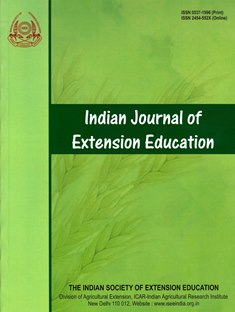Evaluating the Effect of Extension Advisory Services (EAS) using Economic Index Score in Aspirational Districts
DOI:
https://doi.org/10.48165/IJEE.2025.61311Keywords:
Economic Index Score (EIS), Extension Advisory Services (EAS), Aspirational Districts, Rural livelihoods and Economic well-beingAbstract
The Aspirational Districts Programme (ADP) aims to uplift India’s most developmentally lagging regions through targeted interventions across health, education, agriculture, and infrastructure. The study evaluated the economic impact of EAS on farmers in four aspirational districts of Bihar and Jharkhand using a novel Economic Index Score (EIS) during 2024-25. The EIS was constructed using five key dimensions viz., employment generation, asset creation, agricultural productivity, cost reduction, and value addition, capturing both the presence and duration of economic benefits from EAS. The data were collected from 320 farmers and 30 service providers personally. The statistical analysis, including Welch’s ANOVA, Games-Howell post hoc tests, and Bayesian inference, revealed significant differences in EIS between beneficiary and non-beneficiary farmers, with a moderate to large effect size (Cohen’s d = 0.61). The district-wise comparisons also highlighted disparities, with Muzaffarpur showing the highest economic gains and Hazaribagh the lowest. The correlation analysis identified experience, mass media exposure, social participation, and extension contact as significant predictors of EIS. The findings established that EAS plays a crucial role in enhancing rural livelihoods, yet variations across districts and farmer profiles underscore the need for context-specific, inclusive extension models.
Downloads
References
Abhiguru, P., Birthal, P. S., & Ganesh, K. B. (2009). Strengthening pluralistic agricultural information delivery systems in India. Agricultural Economics Research Review, 22(1), 71-79. http://oar.icrisat.org/id/eprint/7537
Alzahrani, K., Ali, M., Azeem, M. I., & Alotaibi, B. A. (2023). Efficacy of public extension and advisory services for sustainable rice production. Agriculture, 13, 1062. https://doi.org/10.3390/agriculture13051062
Anderson, J. R., & Feder, G. (2007). Agricultural extension. Handbook of Agricultural Economics, 3, 2343-2378. https://doi.org/10.1016/S1574-0072(06)03044-1
Bahua, M. I., Jahi, A., Asngari, P. S., Saleh, A., & Purnaba, I. G. P. (2013). Factors affecting the performance agricultural extension and their impact at behavior maize farmers in Gorontalo Province. The Journal of Agricultural Education and Extension, 1, 1-10.
Bhavani, R. V. (2023). The National Commission on Farmers, 17 years on. Review of Agrarian Studies, 13(2), 80-86. https://doi.org/10.25003/RAS.13.02.0008
Chand, R., Saxena, R., & Rana, S. (2015). Estimates and analysis of farm income in India, 1983–84 to 2011–12. Economic and Political Weekly, 139-145. http://www.jstor.org/stable/24482496
Davis, K., Bohn, A., Franzel, S., Blum, M., Rieckmann, U., Raj, S., Hussein, K., & Ernst, N. (2018). What works in rural advisory services? Global good practice notes. Lausanne, Switzerland: Global Forum for Rural Advisory Services. http://www.betterextension.org
Deaton, A. (1997). The analysis of household surveys: A micro econometric approach to development policy. The World Bank.
Filmer, D., & Pritchett, L. (2001). Estimating wealth effects without expenditure data—or tears: An application to educational enrolments in states of India. Demography, 38(1), 115-132. https://doi.org/10.1353/dem.2001.0003
Jaiswal, M., Singh, A., Singh, B., & Singh, K. (2018). Assessment the usefulness, applicability & impact of Kisan Mobile Advisory Services (KMAS) by the farmers in Burhanpur district of Madhya Pradesh. Indian Journal of Extension Education, 54(3), 31-36. https://epubs.icar.org.in/index.php/IJEE/article/view/143882
Kumar, Y., Fatima, K., Raghuvanshi, M. S., Nain, M. S., & Sofi, M. (2022). Impact of Meghdoot mobile App - A weather-based agro advisory service in cold arid Ladakh. Indian Journal of Extension Education, 58(3), 142-146. http://doi.org/10.48165/IJEE.2022.58329
Kumar, Y., Fatima, K., Raghuvanshi, M. S., Namgyal, D., Nain, M. S., Manhas, J. S., Kanwar, M. S., Sofi, M., Singh, M., & Angchuk, S. (2021). Impact assessment of weather-based agro-advisory services of Indus plain farming community under Cold Arid Ladakh. MAUSAM, 72(4), 897-904.
Ministry of Agriculture & Farmers Welfare. (2023). Annual report 2022–23. Government of India. Retrieved March 20, 2024 from https://agriwelfare.gov.in/Documents/AR_English_2023_24.pdf
Nagar, A., Nauriyal, D. K., & Singh, S. (2021). Determinants of farmers’ access to extension services and adoption of technical inputs: Evidence from India. Universal Journal of Agricultural Research, 9(4), 127-137. https://doi.org/10.13189/ujar.2021.090404
NITI Aayog. (2022). Aspirational districts programme: An appraisal. Government of India. Retrieved April 15, 2024 from https://www.niti.gov.in/sites/default/files/2023-03/Aspirational-DistrictsProgramme-An-Appraisal.pdf
Priscilla, L., Kar, P., Krishnadas, O., Nivetina, L., & Sharma, P. R. (2021). Economic impact of crop diversification in North-East India: Evidence from household-level survey. Indian Journal of Extension Education, 57(4), 104-109. https://epubs.icar.org.in/index.php/IJEE/article/view/115529
Sentibenla, P., & Jha, K. K. (2024). Information sources utilization and adoption behaviour of pineapple growers in Nagaland. Indian Journal of Extension Education, 60(1), 46-52. https://doi.org/10.48165/IJEE.2024.60109
Singh, M., Burman, R. R., Sangeetha, V., & Iquebal, M. A. (2015). Constraints faced in mobile based agro-advisory services and strategy for enhancing the effectiveness of mKRISHI®. Indian Research Journal of Extension Education, 15(2), 119-122. http://www.seea.org.in/vol15-2-2015/24.pdf
Singh, S. S., Saikia, A. R., Saurabh, Leihaothabam, N. S., & Hemam, R. (2023). Insights into agricultural extension. Empyreal Publishing House.
Tayang, W., & Devi, M. N. (2024). Quantitative insights into extension advisory services: Enhancing rural livelihoods through evidence-based analysis. Journal of Experimental Agriculture International. https://doi.org/10.9734/jeai/2024/v46i113080
Venu, L., Singh, B., Kumar, P., & Vijayaragavan, K. (2013). Agricultural extension in India – the effectiveness of the Agricultural Technology Management Agency. Outlook on Agriculture, 42(1), 65-71. https://doi.org/10.5367/oa.2013.0115
World Bank. (2021). Transforming agriculture in India: Vision 2030. Retrieved March 20, 2025 from https://www.worldbank.org/en/programs/sdgs-2030-agenda
Wossen, T., Abdoulaye, T., Alene, A., Haile, M. G., Feleke, S., Olanrewaju, A., & Manyong, V. (2017). Impacts of extension access and cooperative membership on technology adoption and household welfare. Journal of Rural Studies, 54, 223-233. https://doi.org/10.1016/j.jrurstud.2017.06.022
Yaseen, M., Ahmad, M. M., Soni, P., Kuwornu, J. K. M., & Saqib, S. E. (2021). Factors influencing farmers’ utilisation of marketing information sources: Some empirical evidence from Pakistan. Development in Practice. https://doi.org/10.1080/09614524.2021.1911941
Downloads
Published
Issue
Section
License

This work is licensed under a Creative Commons Attribution-NonCommercial-NoDerivatives 4.0 International License.

